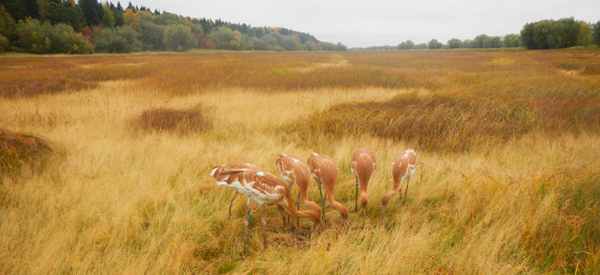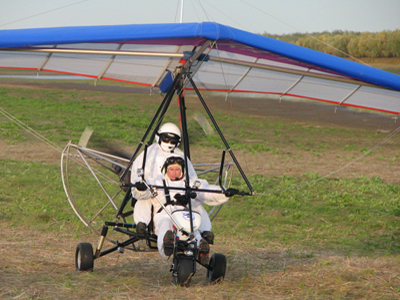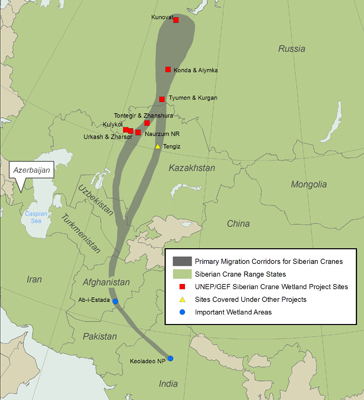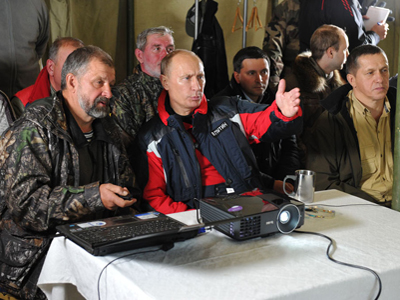
Ten Siberian Crane chicks were reared for the “Flight of Hope” Project at the Oka Crane Breeding Center in western Russia this summer. Last month seven of the chicks were transported to the Kushevat training site located near the Siberian Crane breeding grounds in West Siberia (above). The chicks will be led south this fall using ultralight aircraft to a Eurasian Crane migration stop-over site at Belozersky Wildlife Refuge in southwestern Russia. Photo by Alexander Sorokin
By Elena Ilyashenko, Siberian Crane Flyway Coordinator
Moscow, Russia

On Wednesday, 5 September 2012, Vladimir Putin, the President of the Russian Federation, participated in the “Flight of Hope” Project on the reintroduction of the endangered Siberian Crane in West Asia. The flight has drawn much needed worldwide attention to the conservation of this species.
Currently it is estimated that 10-20 Siberian Cranes survive in the Western/Central Asian population. Siberian Crane conservation and reintroduction efforts have been undertaken since the 1970s with cooperation and friendship among Russian scientists led by Professor Vladimir Flint and George Archibald and his colleagues at the International Crane Foundation (ICF). In 1979, the breeding center for rare cranes was constructed at the Oka State Nature Reserve (Oka Crane Breeding Center, or OCBC) to create a captive population with the goal of reintroducing the cranes into the wild. Up to now the OCBC has had great success rearing cranes with the help of the ICF, where staff underwent training on crane rearing and veterinary care. As a result, OCBC has reared Siberian and Red-crowned Cranes for reintroduction programmes, as well as other crane species for zoos and other breeding centres. For a number of years OCBC activity was supported by the Cracid & Crane Breeding and Conservation Centre.
After creation of a captive flock at OCBC, a reintroduction program for the Siberian Crane was launched in the early 1990s by the Oka State Nature Reserve, All-Russian Research Institute of Nature Protection (Moscow), and ‘Sterkh” Foundation (Salekhard, West Siberia). Since the beginning of the reintroduction program over 100 captive-bred chicks have been released on the species’ breeding and wintering grounds. Ten sightings of banded birds have been reported following release.
The “Flight of Hope” Project is a part of this wider reintroduction program for the Siberian Crane. It was modeled after the North American project to reintroduce the endangered Whooping Crane. The project is being successfully implemented by the Whooping Crane Eastern Partnership that includes governmental and non-governmental organizations like ICF and Operation Migration, and private sponsors. ICF provided support to several Russian colleagues who participated in the rearing and ultralight-led Whooping Crane migration to gain experience to adapt for the “Flight of Hope” Project. The goal of this project is to lead captive-bred cranes along their migration routes to the wintering grounds by following a motorized ultralight plane. The pilot of the ultralight aircraft plays the role of parents, which show chicks their flyway during their first migration from breeding grounds to wintering sites. Experience shows that chicks successfully return to the place where they took their first flights when they return north the following spring.
The idea of the “Flight of Hope” Project was born in Russia in the 1990s and discussed by Range state signatories of the Memorandum of Understanding concerning Conservation Measures for the Siberian Crane under the Convention on Migratory Species (CMS).
The project was started in 2002 with participation of a famous hang glider pilot, Angelo D’Arrigo. An experiment was conducted to use a hang glider that could rise on warm air thermals and then soar long distances similar to the flight strategy of migrating wild cranes. However, in 2002 the cold and rainy weather conditions did not allow the cranes to follow the hang glider.
In 2006, the project was continued using a motorized ultralight plane. However, the ultralight flew much faster than the birds. Therefore some time was needed to construct the special motorized hang-glider for the “Flight and Hope” Project, more suited to flying cranes.

In 2012, ten Siberian Crane chicks were reared for the “Flight of Hope” Project at the Oka Crane Breeding Centre. Starting when they hatched, the chicks were trained to follow an ultralight plane during feeding so they would not be scared by the engine noise. When the chicks started to fly they were trained to follow a flying ultralight at a special site within the nature reserve. On 16 August, the seven strongest chicks were transported to the Kushevat training site located near the breeding grounds of the Siberian Crane in West Siberia, where training flights were continued. Kushevat was selected as the take-off site for the flock to begin their migration following the motorized hang glider.
Migration routes of wild Siberian Cranes go from West Siberia through Kazakhstan, Turkmenistan, Uzbekistan, Afghanistan, and Pakistan to India. This route is not safe, especially in Afghanistan and Pakistan, where crane hunting and catching are traditional.
Therefore, for the “Flight of Hope” Project it was decided to lead cranes to the wintering grounds of Eurasian Cranes in the Amudaria River Valley, located near the town of Termez, close to the border between Uzbekistan and Afghanistan. The Eurasian Cranes have moved their wintering sites north, we believe in response to climate change. This site is considered as potential Siberian Crane wintering grounds, since it is close to the traditional migration route to India, but ends before the cranes reach areas with higher hunting pressure.
But in 2012 it was planned to lead the cranes to the Belozersky Wildlife Refuge in southern Russia instead, where flocks of Eurasian Cranes stop to rest and replenish their reserves during migration. Therefore, our Siberian Cranes will be able to join the Eurasian Crane flock and continue their migration to the south along with the wild cranes, as did the captive-bred Siberian Cranes released at this site in previous years.
All these years the “Flight of Hope” project was implemented by top experts led by Dr. Alexander Sorokin, the Head of Laboratory of Biodiversity of the All-Russia Research Institute of Nature Protection (ARRINP) and Vice-president of the Crane Working Group of Eurasia. The core project team includes Anastasia Shilina, ARRINP researcher; Yuri Markin, Director of Oka State Nature Reserve; Tatiana Kashentseva, Head of OCBC; Yuri Zapsetin, OSNR staff; and Alexander Ermakov, the Head of the Sterkh Foundation.
Since the beginning of the project, the oil and gas company ITERA has supported implementation, and the Ministry of Natural Resources and Environment of the Russian Federation backed the project in 2012 providing 12 million rubles to reconstruct and improve the facilities at the OCBC, rent helicopters, cover transport costs and other expenses. President Vladimir Putin made his own contribution to the “Flight of Hope” Project by donating a motorized hang-glider.
Vladimir Putin had arrived in West Siberia on 4 September to learn about and support the “Flight of Hope” Project, to learn about the state of biodiversity conservation in Russia, and to meet with the project staff and other agencies responsible for nature conservation. President Putin has a pilot’s license and wanted to do a training flight with cranes. After the flight, when several cranes followed his hang glider, Mr. Putin said that he had greatly enjoyed flying with the cranes and hoped that this project will have success.

The participation of Vladimir Putin in the project and his interest will contribute to the successful implementation of the “Flight of Hope” project in the years to come. This event will attract attention to the importance of such projects in conservation of the rare species. In previous years the President participated in projects on the conservation of tigers and leopards in the Far East, snow leopards in Altai, polar bears in Arctic, gray whales near Kamchatka, and Beluga whales in the Okhotsk Sea. As a result of his participation in these projects, for example, breeding centers for tigers and leopards were created, a national park for leopards in the Far East was established and a programme on garbage removal in the Russian Arctic was launched. Considerable financial support has been provided for research into these species. Conservation projects on species where Vladimir Putin took part were proposed by scientists, including concerned species such as the Amur tiger, the leopard, the polar bear, the Siberian Crane, the Gray whale and the Beluga whale, all of which are flagship species for conservation of ecosystems and other less charismatic, but nonetheless important species.
